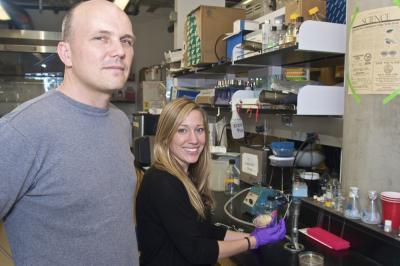The researchers studied uropathogenic E. coli (UPEC), which causes urinary tract infections in humans, and discovered a sibling-like link between cell systems that have largely been thought of as rivals. The paper shows that bacteria expressing a contact-dependent growth inhibition system (CDI) can inhibit bacteria without such a system, but only if the target bacteria have CysK, a metabolic enzyme required for synthesis of the amino acid cysteine. For a cell system typically thought of as existing only to kill other bacteria, as CDIs have largely been, the results are surprising, said Christopher Hayes, UC Santa Barbara associate professor of molecular, cellular, and development biology, because they suggest that a CDI+ inhibitor cell has to get permission from its target in order to do the job.

Associate professor Christopher Hayes and graduate student Christina Beck. Credit: Rod Rolle
"This is basically the inhibitor cell asking the target cell, 'Can I please inhibit you?'" Hayes explained. "It makes no sense. Why add an extra layer of complexity? Why add a permissive factor? That's an unusual finding. We think now that the [CDI] system is not made solely because these cells want to go out and kill other cells. Our results suggest the possibility that these cells may use CDI to communicate as siblings and team up to work together; for example, in formation of a biofilm, which lends bacteria greater strength and better odds of survival."
The study points to the enzyme CysK as the potential catalyst to such bacterial communication –– like a secret handshake, or a password. In simpler terms, said Hayes, "If you have the right credentials, you're allowed into the club; otherwise you're turned away. There's a velvet rope, if you will, and if you're not one of the cool kids, you can't get in."
Although only UPEC was studied for this paper, Hayes said that the findings hold potential implications for pathogens from bacterial meningitis to the plague, as well as for plant-based bacteria that can devastate vegetation.
"We are just starting to get some clues that bacteria may be talking to each other with a contact-dependent language," said David Low, a UCSB professor of molecular, cellular, and developmental biology. "They touch and respond to one another in different ways depending on the CDI systems and other genotypic factors. Our hope is that ultimately this work may aid the development of drugs that block or enhance touch-dependent communication, whether the bacteria is harmful or helpful."
Published in Genes&Development





Comments